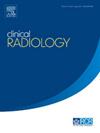Ultrasonographic assessment of the uterocervical angle in the second trimester of pregnancy as a predictor of spontaneous preterm birth
IF 2.1
3区 医学
Q2 RADIOLOGY, NUCLEAR MEDICINE & MEDICAL IMAGING
引用次数: 0
Abstract
AIM
To evaluate the uterocervical angle in the second trimester in singleton pregnancies as a predictor of spontaneous preterm labour.
MATERIAL AND METHODS
An observational cohort study was carried out from March 2022 to May 2023, including consecutively selected patients with singleton pregnancies who underwent routine examinations between 18.0 and 23.6 weeks to analyse the risk of prematurity. The uterocervical angle (UCA) measurement was added to the transvaginal ultrasonographic analysis of the cervix. Birth-related outcomes were prospectively collected.
RESULTS
patients were evaluated. The occurrence of spontaneous preterm birth (sPTB) before 37 weeks was 12%, with 50 patients. An association was observed between a more obtuse uterocervical angle and the occurrence of birth before 37 weeks, with the area under the curve of 0.636 (p=0.003; 95% CI: 0.546–0.726). The cutoff point of 77.2 degrees demonstrated a sensitivity of 80% and specificity of 29.4% (p=0.003), a positive predictive value of 13.6%, and a negative predictive value of 91.3%, with a positive likelihood ratio of 1.13 and negative 0.88.
CONCLUSION
The measurement of UCA in the second trimester of pregnancy is associated with the occurrence of sPTB. The result corroborates recent literature conclusions that UCA is a relatively recent predictor of sPTB. New evidence in different populations may contribute to its possible incorporation into prematurity risk assessment.
求助全文
约1分钟内获得全文
求助全文
来源期刊

Clinical radiology
医学-核医学
CiteScore
4.70
自引率
3.80%
发文量
528
审稿时长
76 days
期刊介绍:
Clinical Radiology is published by Elsevier on behalf of The Royal College of Radiologists. Clinical Radiology is an International Journal bringing you original research, editorials and review articles on all aspects of diagnostic imaging, including:
• Computed tomography
• Magnetic resonance imaging
• Ultrasonography
• Digital radiology
• Interventional radiology
• Radiography
• Nuclear medicine
Papers on radiological protection, quality assurance, audit in radiology and matters relating to radiological training and education are also included. In addition, each issue contains correspondence, book reviews and notices of forthcoming events.
 求助内容:
求助内容: 应助结果提醒方式:
应助结果提醒方式:


